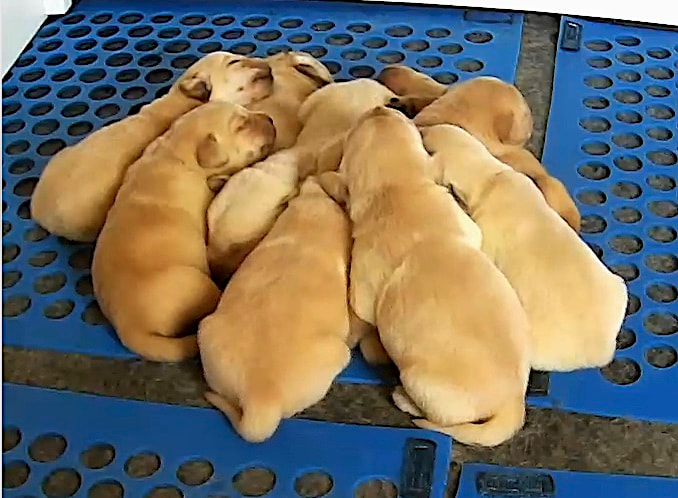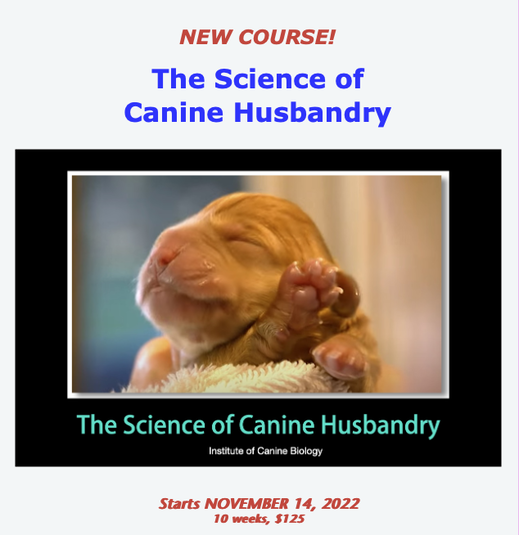A good example of one of these was a study by Welker (1959) to learn how puppies are able to stay in contact with their most important heat sources, their mother and their littermates.
The reason you keep a heat source in your whelping box is because newborn puppies are altricial (not fully developed) at birth. Eyes and ears are closed, and they have only two useful senses (temperature and touch). A physiologist would describe a puppy as a "very simple system".
| Physiological systems are very temperature sensitive. Heart rate, respiration, muscle contraction, vision, digestion, nerve impulse transmission, and many other things are affected by temperature; heat makes physiological processes faster, and cold slows them down. You know from personal experience that if you leave your hand in an ice bucket for a few minutes, then try to pick up a penny from the table, not only can you not pick it up, you can't even feel it. Everything is too cold to function. A cold puppy has the same problems. Respiration is slowed, heart rate and contractility (strength of contraction) declines, digestion stops, and sensory systems don't respond to stimuli. If that wasn't enough, cold muscles mean that the pup can't even move out of the situation to a warmer spot. |
Back in the 1950s, a scientist named Wexler at the University of Wisconsin did some simple but clever experiments to learn about how newborn puppies can avoid hot and cold to maintain a body temperature suited to their physiology. He used a 250 W infrared heat lamp to produce "warm" and "hot" conditions simply by holding it closer (about 1-2 ft away) or a bit farther away (about 4 ft) from the puppy. For a cold condition, he moistened the skin of the puppy with water and used a fan to produce evaporative cooling. This was crude; the experimental conditions were subjective and qualitative, and probably not even repeatable. But it was a simple experiment that anyone could do (both then and now) if you had a heat lamp, a glass of water, a fan, and a puppy.
There were several questions Wexler wanted to address.
- Are puppies able to sense their own body temperate? If they can't do this, they can't take actions to regulate it. This would require the puppy to have a central heat sensor that communicates with the physiological systems involved in a response.
- Can puppies sense hot and cold objects in their environment? A puppy in a place that's too hot needs to know if it's moving towards a place that is coolerr, and likewise for its response to cold.
- Finally all of these must work together to produce the appropriate response by the puppy to get it from a dangerous place to a safe one.
The hot and cold conditions were applied until the puppy produced vocal and behavioral responses. The effects of touching an object just using the fingers applied to various places on the body.
The Puppy Huddle
To address the first question about whether puppies can sense their own body temperature, Wexler put a group of 4 puppies on the table. Under cold conditions, the puppies gathered to form a huddle. After some time in the cold, the puppies became agitated and vocalized, but they only moved around within the pile and not away from it. If a heat lamp was directed at the pile of puppies, they became quiet within a few seconds. If the heat lamp was moved closer, vocalizations and movement began again in response to the higher temperature, and the puppies gradually moved apart from the huddle. When the puppies were all separated from each other to avoid the heat from the lamp, the lamp was turned off and activity and vocalizations stopped. The puppies would gradually cool until once again they got cold enough to stimulate vocalization and movement. This phenomenon worked so well that the puppies could be induced to huddle and disperse over and over, simply by turning the heat lamp on and off.
This demonstrated two things - first, that the puppies could sense their own body temperature and, second, that they could also moderate their response to body temperature with a skin sensor that could detect both pressure when in contact with littermates, and temperature; that is, whether an object was hot or cold.
The behavior of individual puppies in response to heat or cold was even more interesting.
A lone puppy in the cold sweeps its head from side to side, emitting a cry with each respiration, and occasionally moves forward a short distance. Similar side to side movements of the head occur under hot conditions, again with cries on respiration. While it might take 30 to 60 seconds with the heat lamp turned on to simulate the head movements and vocalizations, both stopped almost immediately when the lamp was turned off. If the lamp was turned on again, the response of the puppy was almost immediate, in contrast to the slower response with the first exposure to heat. This would require thermal sensors on the skin that stimulate a central receptor almost immediately.
|
Wexler found that, in the cold, simply touching a puppy could elicit a striking behavior response. A cold puppy would stay more or less in the same place while crying and moving about, but with the touch of two fingers on either side of the tip of the nose, the puppy would move forward quickly, about 3.5 ft in only 15 seconds. This did not happen unless the touch was bilateral, with fingers on the sides of the tip of the nose. Bilateral touching of the sides of the head (instead of the tip of the nose) elicited movement forward, but to a lesser degree. Touching on the neck or body had no effect. If the touch was only on one side (unilateral contact), it caused the puppy to turn in the direction of the stimulus but with no forward progression.
When a puppy was in hot conditions, it vocalized and swung its head from side to side as it did when cold, but touching the nose with a finger caused the puppy to pull away and turn the head away. With bilateral (2 finger) touch, the puppy might move forward a few inches, but touching other parts of the body produced no response.
|
This response of newborn puppies to touch was remarkably strong. A puppy could travel a distance of 50 yards in 15 minutes, stimulated simply by a bilateral touch on the nose. And perhaps even more remarkably, the puppies seemed to be as strong after this distance than when they started.
The Integrated Puppy
A newborn puppy might look helpless, with eyes closed and limited ability to move around, but it has remarkable sensory abilities that allow it to maintain some control of its body temperature and avoid extremes that would be dangerous or deadly. We know from simple studies like the one described here that puppies can sense their own body temperature, determine whether it is too high or too low, and take actions to move to a more thermally suitable place. The puppy can sense when it touches something and whether it is hot or cold, and it will move forward in response to a touch on the nose, something that might help it stay with its siblings or mother.
What might look like random, pointless movements of puppies in your whelping box are actually evidence of the actions a newborn puppy takes to keep its body temperature in a suitable range for growth and physiological functions. Over the next days and weeks, the physiology of the puppy will mature and it will be able to generate and retain enough metabolic heat to maintain a stable body temperature, at which time it is able to become more independent.
You can learn more about the science of dog breeding in my new online course, "The Science of Canine Husbandry", which is available through the Institute of Canine Biology.
Welker, WI. 1959. Factors influencing aggregation of neonatal puppies. J. Comp. Physiol. Psych., 52(3), 376-380. https://doi.org/10.1037/h0047414
ICB's online courses
***************************************
Visit our Facebook Groups
ICB Institute of Canine Biology
...the latest canine news and research
ICB Breeding for the Future
...the science of animal breeding



